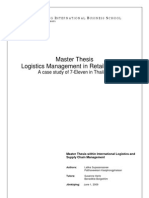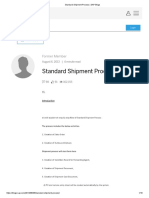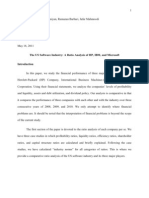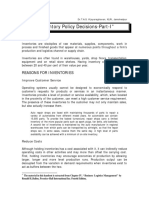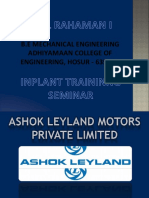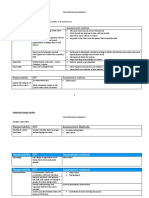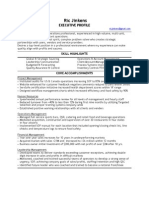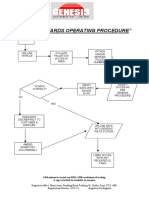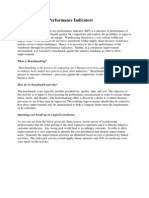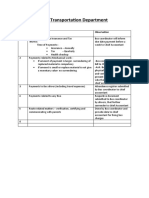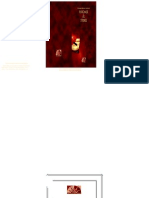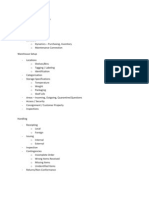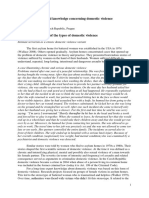SCLM Checklist
SCLM Checklist
Uploaded by
Mayur GaidhaneCopyright:
Available Formats
SCLM Checklist
SCLM Checklist
Uploaded by
Mayur GaidhaneOriginal Title
Copyright
Available Formats
Share this document
Did you find this document useful?
Is this content inappropriate?
Copyright:
Available Formats
SCLM Checklist
SCLM Checklist
Uploaded by
Mayur GaidhaneCopyright:
Available Formats
Please Note: This is a checksheet of SCLM and does not consist of notes .
It is useful only to check whether you know the mentioned concepts. Draw Diagrams wherever it is necessary .Refer the Book SCLM Donald Bowersox. Almost all concepts are explained with Diagrams Drawings help to remember the concept as well as it helps to impress the examiner.
.
1. TWENTY FIRST CENTURY SUPPLY The Supply Chain Revolution Generalized Supply Chain Model
CHAINS
Supply chain and networks Extended organization Features of Integrative Management Responsiveness Financial sophistication Globalization Digital Business Transformation Page 6 The Supply Chain Revolution Two massive shifts which are highly interrelated 1.The Supply chain revolution 2.Logistical Renaissance The supply chain consists of firms collaborating to improve strategic positioning and operational efficiency. Supply chain links trading partners and customers across organizational boundaries. In contrast to supply chain LOGISTICS is the work required to move and position inventory throughout the supply chain.
It is a subset of supply chain and occurs within the broader framework of a supply chain Logistics process creates value by timing and positioning inventory Logistics is the combination of a firms order processing inventory, transportation, warehousing, material handling and packaging as integrated throughout the facility network. INTEGRATED LOGISTICS links and serves overall supply chain as a continuous supply chain process. It is essential for effective supply chain connectivity. The purpose of logistics has remained the same but the way of performance has changed radically Supply chain decisions establish the operating framework within which logistics is performed To overcome the challenges of commercial trading, firms developed business relationships with other product and service companies to jointly perform essential activities. Mangers started strategic planning core competancy, specilaization and economy of scale. It was realized that working closely with other businesses was essential for continuous success. Acknowledged dependence between business firms created the study now known everywhere as Distribution or Marketing Channel. Wholesalers started giving better service and compensation to firms. The firms realized the importance of leadership, cooperation and resolving conflict. Scholars developed typologies to classify single transaction and continuous business relationships. The firms started focusing on individual goals The channel dynamics was more characterized by dog eat dog environment. There was rapid advancement in computer and IT and digital business transformation. The firms took great advantage of high connectivity potential of Internet.
Generalized supply chain model ----Figure It comprise of multifirm collaboration within a framework of key resource flows and constraints. Within this the strategy and structure forms by aligning with customers as well as distribution and supply networks to gain competitive advantage. Business operations are integrated from initial material purchase to delivery and services to customers. Value in this model results from five critical flows i.e. Information, product, service, financial and knowledge. This generalized model links distributors and supply networks to customers. The figure conveys the message that integrated value creation must be aligned from material procurement to end customer. The reason being this model gained importance is many firms simultaneously participate in multiple and competitive supply chains. So the supply chain itself becomes basic unit of competition. The firms then confront loyalty issues such as confidentiality and conflict of interest The reason being this model gained importance is many firms simultaneously participate in multiple and competitive supply chains. So the supply chain itself becomes basic unit of competition. The firms then confront loyalty issues such as confidentiality and conflict of interest
Integrative Management This results from practice of performing and measuring work on functional basis(each task ). Accounting practices to measure departmental performance. Individual performance Cost per unit to produce Cost per unit to hundredweight to transport. These do not necessarily achieve the desired result of lowest cost or highly effective process. On the other hand Integrated management
Seeks to identify lowest total cost and captures tradeoffs between functions. For example the firm might use faster, dependable premium transportation even if its cost is high .Because its cost is much affordable than the cost incurred in handling and maintaining an inventory. The main focus of integrated management is lowest total process cost.
Integrative Management-Collaboration Integrative Management comprise of Collaboration Enterprise Extension Integrated Service providers
The fundamental belief behind the Enterprise Extension is that the firms integrate process will maximize customer impact, reduce overall risk and greatly improve efficiency. Enterprise extension builds on two basics Information sharing Process specialization Integrative Management -Enterprise Extension
The fundamental belief behind the Enterprise Extension is that the firms integrate process will maximize customer impact ,reduce overall risk and greatly improve efficiency. Enterprise extension builds on two basics Information sharing Process specialization Jointly form strategies and share information Plans promotion ,new product introduction and day to day operation and not only current or historical sales data.
Joint operation with goal to eliminate non value added ,non productive functions. Uses specific firms competency along with responsibility and accountability Integrative Management-Responsiveness
Instead of anticipatory business practice to the time based responsive business model is more important . This model seeks to reduce or eliminate forecast dependence by jointly planning and rapid exchange of information between partners. Integrative Management-Responsiveness------ Figure Responsive business Model----Figure
Integrative Management-Financial Sophistication This can be achieved by faster, flexible and more precise ways of serving with competitive price. Three ways Cash to cash conversion Dwell time minimization Cash spin Integrative Management-Globalization Import and Export Local presence in foreign nations Through franchisee ,licensing , manufacturing and distribution Full fledge conduct of business operations This is most advance phase , referred to as Globalization Important factors Distance
Diversity Documentation Demand Terrorism Security Complex and costly The cost of logistics is estimated to exceed 6 Trillion dollars. Still it is beneficial because of Market potential expansion and operating efficiencies. The risk can be controlled and minimized through Integrative Management.
Integrative Management-Digital Business Transformation IT is use of Information technology to reinvent and position business operations, processes and relationships and facilitate supply chain collaboration to achieve unprecedented level of excellence. DBT seeks to meet challenges and identify opportunities of responsiveness, financial sophistication and globalization Expands Internet capabilities from one to one, one to many and many to many through web based solutions. The participating firms have same strategic as well as operational information. Synchronized distribution of information across supply chain. Transition from Industrial age to Information age
2. LOGISTICS: The Logistics Of Business - The Logistical Value PropositionTheWork Of Logistics-Logistical Operating Arrangements - Flexible Structure Supply Chain Synchronization.
The logistics of Business Logistical operations of global commerce has become large and complex Logistics adds value to the supply chain by strategically positioning goods to achieve sales. But creating this value is costly But it is important to achieve competitive edge through logistical competency Companies provide in advance the problems those may occur thus eliminate customers future loss By following the above logistically sophisticated forms achieve availability of inventory, speed and consistency, operational efficiency It is meant by service and cost minimization In todays environment economics and not technology is a limiting factor
Logistical value proposition consists of; 1. Service benefits 2. Avalilability 3. Operational performance; Flexibility, Recovery time, malfunction
4. Service reliability 5. Quality Cost minimization: The logistics value proposition US Logistics cost----
The work of logistics 1. Order processing 2. Invenory management Pareto priciple Core customer segmentation Product profitability Transportation Integration Time based performance Competitive performance 3. Transportation 4. Warehousing Material handling and Packaging 5. Facility network design
Logistical operations pg.31 1.Inventory Flow 2.Customer accommodation 3.Manufacturing support 4.Procusrement 5.Information flow
Logistical operating arrangements ----page 32,34,35, 1. Echelon Structure 2. Direct Structure 3. Combined Structure Supply chain synchronization-page 40 Performance cycle structure Performance cycle uncertainty-page 41
3. CUSTOMER ACCOMMODATION: Customer Focused Marketing Customer Services-Customer Satisfaction -Customer Success-Forecasting
Customer focused marketing Customer focused marketing Transactional versus Relationship marketing Supply chain service outputs Spatial convenience Lot size Waiting time Product variety and assortment
Customer service 1.Availability 2.Stockout frequency 3.Fill rate 4.Order shipped Complete Operational performance 1.Speed 2.Consistency 3.Flexibility 4.Malfunctin recovery 5.Service Reliability
The Perfect order and Basic service platforms
Customer satisfaction Expectancy disconfirmation Customer Expectation Customer satisfaction Expectancy disconfirmation Customer Expectation
Customer satisfaction and quality model Gaps 1.Knowledge 2.Standards 3.Performance 4.Communication 5.Perception 6.Satisfaction/Quality Increasing customer expectations Limitations of customer satisfaction Page 59
Customer success Page 60 Achieving customer success Page 61,63
Value added services Forecasting Forecasting requirements Collaborative planning Requirement planning Resource management
Forecasting components Forecasting process Page 66
Technique Qualitative Time Series, Moving average Extended Exponential smoothing Adaptive smoothing Causal-Multiple and Simple
Support system Administration
Forecasting accuracy Page 73 Collaborative planning, Forecasting and Replenishmentfig 74 Customer relationship management ---page 75
4. PROCUREMENT AND MANUFACTURING: The Quality ImperativeProcurement Manufacturing-Logistical Interfaces. The quality Imperative Dimensions of Quality
Performance Reliability Durability Conformance Aesthetics Serviceability Perceived quality Total Quality Management Quality Standards: ISO Procurement
Procurement perspectives Continuous supply Minimize Inventory investment Quality improvement Supplier development Lowest total cost of ownership Procurement strategies
page 85 Volume consolidation Supplier operational integration Value management Page 87
Purchase requirement segmentation E commerce and procurement
Manufacturing Manufacturing perspectives Brand Power Volume Variety Constraints;-Capacity,equipment,setup Scalability Leadtime; Operational and inoperational Manufacturing strategies Matching manufacturing strategies to market requirements Alternative manufacturing strategies Make to plan MTP Make to Order MTO Assemble to order Make to stock MTS Total cost of manufacturing page 94 Logistical interfaces JIT Requirement Planning Design for logistics page--96 5. INFORMATION TECHNOLOGY FRAMEWORK: Information System Functionality-Comprehensive Information System Integration-
Communication Technology-Rationale For ERP Implementation-ERP System Design-Supply Chain Information System Design.
Information System functionality Supply chain information system Transaction system Management control Decision analysis Strategic planning Information functionality page 100,101
Comprehensive information system integration ERP or legacy systems Page 102 Communication system Executive system Planning system
Communication technology Bar coding Page 104 Global data synchronization EDI Transaction sets Fig--page106 Electronic product code Radio frequency exchange Internet
Page 109 Electronic industry exchange portal Extensible markup language Satellite Image processing
Rational for ERP Implementation 1.Consistency 2.Economics of scale 3.Integration
ERP System design Central database Customer file Product price file Supplier file Order file BOM PO Inventory file History file
Operations Order processing Order assignment
Warehouse operations Transportation and shipping Procurement Supply chain information system design
Page 118 Planning / coordination Sales and operations plan Capacity constraints Logistics requirements DRP Manufacturing requirements Procurement requirement Inventory Deployment and Management
Operations system functionality Page 123
6. INVENTORY: Inventory Functionality and Definitions-Inventory Carrying Cost-Planning Inventory-Managing Uncertainty-Inventory Management Policies-Inventory Management Practices. Inventory functionality and definitions 1.Geographical specilization
2.Decoupling 3.Balancing 4.Balancing Supply and Demand 5.Buffering Uncertainity
Inventory Definitions 1.Inventory ploicy 2.Service level Case fill rate Order fill Line fill 3.Average inventory Order quantity Safety stock
Inventory carrying cost Inventory carrying cost Capital Taxes Insurance Obsolescence Storage
Planning inventory When to order How much to order Volume transportation rates
Quantity discounts Other EOQ adjustments
Managing uncertainty Demand uncertainty Page 142 Page143 Performance cycle uncertainty Safety stock with combined uncertainty Page147 Estimating fill rate Dependent demand replenishment
Inventory Management policies Inventory control Perpetual review Reactive methods of Inventory control Page155
Planning methods Fair share allocation Requirement planning Collaborative Inventory Replenishment Quick response Vendor managed Inventory
Profile Replenishment Page161 Inventory Management practices Product market Classification Page 162 Segment strategy definition Page163 Policies and parameters
7. TRANSPORTATION: Transport Functionality, Principles and ParticipantsTransportation Service - Transportation Economic and Pricing- Transport Administration Documentation. Transport Functionality
Product movement Product storage Transport principles Economy of scale
Economy of distance Transport participants
Shipper and consignee Carrier agents Government , Internet and Public Page 169
Transportation structure Page177
Types Rail Truck Water Pipeline Air
Parameters Modal capability Availability Dependability Capability Transportation service
Traditional carriers Package service-minimum charge Page 185
Air package service
Piggyback/TOFC/COFC Container ships Short sea shipping Land bridge Coordinated Air truck Non Operating Intermediaries
Freight forwarders Shipper association Cooperative and agents Brokers Transportation economics and pricing
Economic drivers Distance Weight Density Stowability Handling Liability Market Page 192 Costing
Variable Fixed Joint Common
Carrier Pricing Strategy
Cost of service Value of service Combination Net rate Rates and rating
Class rates Classification Rate determination Commodity rates Exception rates Special rates and services Freight all kind Proportional rates Transit services Diversion and reconsignment
Split delivery Demurrage Detention Special and accessorial services
Environmental services Transportation administration
Operational management Equipment scheduling and yard management Load planning
Routing and advance Shipment Notification (ASN) Movement Administration-Core career strategy Consolidation Reactive consolidation-market area, scheduled area delivery, Pooled area delivery Proactive consolidation
Preorder Planning Multivendor consolidation Negotiation Control-Tracing ,expediting, hours of service Auditing and claim administration
Overcharge, undercharge Preaudit, postaudit
Logistical Integration
Documentation Bill of lading Order notified Export Government Page 209 Freight Bill Shipment Manifest
8. WAREHOUSING: Strategic Warehousing-Warehousing OperationsWarehousing Ownership Arrangements- Warehouse Decisions Strategic warehousing
Distribution centre local presence Economic benefits Consolidation and Break Bulk Page 215 Sorting Cross docking Mixing Assembly
Lead suppliers Tier one ISP Seasonal storage Reverse logistics process Page 217 Service benfits Spot stocking Full line stocking
Value added services Brights
Warehouse operations 1.Receiving 2.IN storage handling 3.Shiping 4.Storage Page 221 Storage 1.Active storage-Flow through or cross dock distribution 2.Extended Storage Warehouse Ownership Arrangements 1.Private 2.Public
3.Contract Warehousing Network Deployment
Warehouse Decisions 1.Site selection 2.Design 3.Product mix analysis 4.Expansion 5.Materials Handling 6.Layout-Slotting,selection,picking area 7.Sizing Page 227
Warehouse Management Systems(WMS) 1.Descrete selection 2.Wave Selection 3.Batch Selection Page 231 Warehouse considerations
Accuracy and Audits Security Pilferage Damage Safety and Maintenance
9. PACKAGING AND MATERIALS HANDLING: Packaging PerspectivesPackaging For Materials Handling Efficiency-Materials Handling.
Packaging Perspectives Consumer focussed Industrial focused Master cartoons Containerization Unitization Page 237 Packaging for material handling efficiency
Package Design Cubes out Weigh out Unitization
Rigid Containers Page 239 Flexible Containers
Pallets or Slipsheets Fig page 240,241 Communication Master Handling
Basic handling considrations Mechanized Semiautomated Automated Information Directed
Mechanized Systems
Lift Trucks Rider Trucks Towlines Tractor Trailers Conveyers Carousels Semiautomated Systems
Automated Guided Vehicles Sortation Robotics Live Racks
Automated Systems Potential to automate Order Selection Automated Storage / Retrieval Page 247 Information Directed Systems
RF Wireless Wi Fi Task interleaving Pick to light Special Handling considerations E-fulfillment Environmental concerns Regulatory Environment Returns processing Page 231
10. OPERATIONAL INTEGRATION: Why Integration Creates ValueSystemsConcept And Analysis-Logistical Integration Objectives-Enterprise Integration-Supply Chain Processes-Sales And Operations Planning(S & OP)-Supply Chain Planning Considerations-Pricing. Why integration creates value?
Economic value Market value Convenient product service assortment and choice System concept and Analysis Logistical Integration objectives Responsiveness Variance reduction Inventory Reduction Shipment consolidation Quality Life cycle support Enterprise Integration
The Great Divide How much integration is enough? Supply chain process Page 261 Supply chain visibility Simultaneous Resource considerations Resource utilization Sales and Operations Planing(S&OP) Page 263,264 Supply chain planning applications Demand Management Production planning Requirement planning Transportation planning APS System overview Page 267 Supply chain Planning considerations Bolts on Internal integration barriers Organization-Sandox or silo Measurement and Reward system Inventory Leverage Infocratic structure Knowledge Hoarding
Best of Breed Pricing Debundle FOB Pricing Delivered pricing-Single zone, Multiple zone and base point Delivered pricing Phantom freight Fig page 273 Pricing issues-Potential discrimination Quantity discounts Pick up allowances Promotional pricing Menu pricing Platform service price Value added service cost Efficiency incentives-activity based, cost to serve
11. GLOBAL STRATEGIC POSITIONING: Global Supply Chain IntegrationSupply Chain Security-International Sourcing. Managing the Global Supply chain Performance cycle structure Transportation Operational considerations Information system Integration Alliances Supply Chain Security Business continuity planning Siliency Mad cow disease Global supply chain integration Logistics in global economy Page 283 Stages of International development Export / Import-A National perspective Local presence-International operations Globalization-The stateless enterpirse
International Sourcing Rationale for low cost country Sourcing Challenges for low cost country sourcing Guidelines for sourcing
12. NETWORK INTEGRATION: Enterprise Facility Network- Warehouse Requirements-Total Cost Integration-Formulating Logistical Strategy Enterprise facility network
Localized or ubiquitous Material index Locational weight Spectrum of location decision Local presence an absolute paradigm Warehouse Requirements
Supply facing warhouse Demand facing warhosue Procurement drivers Manufacturing drivers Customer accomodatin Drivers Rapid replenishment Market based ATO Warehouse justification Total cost integration Transportation economics
Quantity priciple Tapering priciple
Warehouse Justification Cost based warehouse justification Page 304 ,305 Inventory economics
service based warehouse justification Base, transit and Safety stock Page 307 Network inventory cost minimization
Page 310 Total cost network
Page 310 Trade off relationship Assumption and limitation-Envelop curve Fig page 312 Formulating logistical strategy Cost minimization Threshold service-availability ,capability Page 314 Service sensitivity analysis Locational modification Fig page 315 Performance cycle modification Safety stock modification Finalizing strategy Page 318
13. RELATIONSHIP DEVELOPMENT AND MANAGEMENT: Development And Management Of Internal Logistics Relationships-Development And Management of Supply Chain Relationships Page 355 Functional aggregation A shift in emphasis from function to process Page 359 Virtuality and organization Transparency Leading organization change Development and management of Supply chain relationship Risk, Power and leadership Core competency Disproportionate risk Leadership The range of extended Supply chain relationship Page 365 Supply chain integrative framework Page 366,367 Framework Constructs Page 368 Developing Trust Reliability and character based trust Distributive trust
Procedural justice Building trust in relationships
14. E COMMERCE AND SCM: E commerce advantages and disadvantages for SCM e-commerce as an enabler evolution of world class supply chains EDI Exchanges, hubs and marketplaces ERP.
You might also like
- FSM Haccp Butter ChickenDocument26 pagesFSM Haccp Butter ChickenAYMAN ZEHRANo ratings yet
- Monica Lewinsky and ShameDocument26 pagesMonica Lewinsky and ShameTracy EverbachNo ratings yet
- 5S Best Practices For Lean WarehousingDocument3 pages5S Best Practices For Lean WarehousingDharmvir UppalNo ratings yet
- Supplier On-BoardingDocument8 pagesSupplier On-BoardingKareem RasmyNo ratings yet
- Logistics NotesDocument28 pagesLogistics NotesadnanbmsNo ratings yet
- Transportation ManagementDocument26 pagesTransportation ManagementPragya2818100% (1)
- Warehousing & Inventory Management: Sequence of Warehousing DecisionsDocument11 pagesWarehousing & Inventory Management: Sequence of Warehousing Decisionspuneetgaur9744100% (1)
- Sales SOPDocument2 pagesSales SOPmahbub khanNo ratings yet
- Director Supply Chain in Washington DC Resume Steven BoemermanDocument2 pagesDirector Supply Chain in Washington DC Resume Steven BoemermanStevenBoemermanNo ratings yet
- Limitations of Balance SheetDocument6 pagesLimitations of Balance Sheetshoms_007No ratings yet
- Logistic in RetailDocument78 pagesLogistic in RetailNguyen Thi Thanh NgaNo ratings yet
- Transport Risk Assessment and Verification - From Theory To PracticeDocument2 pagesTransport Risk Assessment and Verification - From Theory To PracticePoppy Tiara100% (1)
- Retail Management Introduction Unit 05Document14 pagesRetail Management Introduction Unit 05Sriram VpNo ratings yet
- Internship Report On: Submitted byDocument30 pagesInternship Report On: Submitted byAsad UllahNo ratings yet
- Mini Warehouse ProposalDocument10 pagesMini Warehouse ProposalAnkit DwivediNo ratings yet
- Warehouse Problems and SolutionsDocument5 pagesWarehouse Problems and SolutionsAshutosh SinhaNo ratings yet
- Order Fulfillment SpecialistDocument3 pagesOrder Fulfillment SpecialistMohd AmeerNo ratings yet
- Category & Commodity Procurement 1Document7 pagesCategory & Commodity Procurement 1reaoboka stanleyNo ratings yet
- Stocks - Physical Verification Guidance NoteDocument2 pagesStocks - Physical Verification Guidance NoteJoão Henrique Machado100% (1)
- Subject: Logistics and Retail Information Credits: 4Document135 pagesSubject: Logistics and Retail Information Credits: 4AKASH JOEL DAVIDNo ratings yet
- International Logistics:: Course Introduction & ObjectivesDocument52 pagesInternational Logistics:: Course Introduction & Objectiveslekha ahlawatNo ratings yet
- Standard Shipment Process - SAP BlogsDocument18 pagesStandard Shipment Process - SAP BlogssreenivasakirankumarNo ratings yet
- Company AnalysisDocument20 pagesCompany AnalysisRamazan BarbariNo ratings yet
- Inventory Policy DecisionsDocument28 pagesInventory Policy DecisionsAnkit KumarNo ratings yet
- Setting Up and Designing Your Warehouse LayoutDocument13 pagesSetting Up and Designing Your Warehouse LayoutSiew Ming SooNo ratings yet
- Inplant Training SeminarDocument24 pagesInplant Training SeminarAbdul RahamanNo ratings yet
- Towards World Class In-Plant Logistics: Hindustan Industries LimitedDocument2 pagesTowards World Class In-Plant Logistics: Hindustan Industries LimitedAravind Maddireddy100% (1)
- Materials Manager Competency ModelDocument24 pagesMaterials Manager Competency ModelSaikumar SelaNo ratings yet
- Implementation of TQM Techniques On Interwood Mobel PVT LimitedDocument80 pagesImplementation of TQM Techniques On Interwood Mobel PVT LimitedFareed AlamNo ratings yet
- Stock Clerk KPIsDocument6 pagesStock Clerk KPIsMama RocksNo ratings yet
- EIS List of Important Questions M 22 4f21b36b 4722 4dd9 A9c8 8579e865858bDocument480 pagesEIS List of Important Questions M 22 4f21b36b 4722 4dd9 A9c8 8579e865858bHarsh GoenkaNo ratings yet
- Warehousing ManagementDocument7 pagesWarehousing ManagementChong King Wei100% (3)
- SOPDocument17 pagesSOPJinal K Shah0% (1)
- Warehousing: Stages of Revolution Stage - 1 Stage - 2Document31 pagesWarehousing: Stages of Revolution Stage - 1 Stage - 2pateldevendraaNo ratings yet
- Inventory CountDocument32 pagesInventory CountKatrina Cassandria RilleraNo ratings yet
- Sales and Operations Planning (SOP) - Demand ForecastingDocument9 pagesSales and Operations Planning (SOP) - Demand ForecastingbakkourNo ratings yet
- Warehouse Management Final Project ReportDocument22 pagesWarehouse Management Final Project ReportNainesh KNo ratings yet
- Rent 1,000,000: S/N Particular UOM Rate Loading Value EMI CostDocument7 pagesRent 1,000,000: S/N Particular UOM Rate Loading Value EMI CostAbhimanyu ArjunNo ratings yet
- Regional Director Multi Unit Restaurant Operations in USA Resume Ric JinkensDocument2 pagesRegional Director Multi Unit Restaurant Operations in USA Resume Ric JinkensRicJinkensNo ratings yet
- Working Capital Management in Icici PrudentialDocument83 pagesWorking Capital Management in Icici PrudentialVipul TandonNo ratings yet
- Rawabi Vallianz Offshore ServicesDocument2 pagesRawabi Vallianz Offshore ServicesMohamed Sallam100% (1)
- Inward PDFDocument4 pagesInward PDFVamsee DeepakNo ratings yet
- Supply Chain ManagementDocument5 pagesSupply Chain ManagementŠ Òű VïķNo ratings yet
- Key Performance Indicators (KPIs) - WarehousingDocument5 pagesKey Performance Indicators (KPIs) - WarehousingPerumal DM100% (2)
- Logistics ManagementDocument16 pagesLogistics ManagementsmtbnmNo ratings yet
- Cadbury Pakistan Limited: "Be The Biggest and The Best Confectionery Company"Document11 pagesCadbury Pakistan Limited: "Be The Biggest and The Best Confectionery Company"Muhammad TariqNo ratings yet
- Procurement - Supply Chain ManagmentDocument21 pagesProcurement - Supply Chain ManagmentIvy100% (1)
- Sop For Transport Dept.Document3 pagesSop For Transport Dept.Audit helpNo ratings yet
- Stores & Purchase SopDocument130 pagesStores & Purchase SopRoshni Nathan100% (4)
- Warehouse ProcedureDocument2 pagesWarehouse ProcedureSherry-Ann CallanNo ratings yet
- Procurement Policy and ProceduresDocument33 pagesProcurement Policy and ProceduresrubyNo ratings yet
- Working With and The Benefits of A 3PL Ebook PDFDocument84 pagesWorking With and The Benefits of A 3PL Ebook PDFandri sofyanNo ratings yet
- Logistics KPIs NewDocument1 pageLogistics KPIs NewSunil Sahu100% (1)
- Purchasing and Payment Policy and Procedures: Responsible University OfficialsDocument31 pagesPurchasing and Payment Policy and Procedures: Responsible University Officialsnitika sehrawatNo ratings yet
- Job DescriptionDocument4 pagesJob DescriptionSilpa VipenNo ratings yet
- Logistics OperationDocument21 pagesLogistics OperationCJ David100% (1)
- Physical InventoryDocument25 pagesPhysical InventoryDexter G. BatalaoNo ratings yet
- Logistics And Supply Chain Management System A Complete Guide - 2020 EditionFrom EverandLogistics And Supply Chain Management System A Complete Guide - 2020 EditionNo ratings yet
- Thermax: Corporate Social ResponsibilityDocument7 pagesThermax: Corporate Social ResponsibilityMayur GaidhaneNo ratings yet
- Logistics & Supply Chain ManagementDocument11 pagesLogistics & Supply Chain ManagementMayur GaidhaneNo ratings yet
- ' All India Shree Shivajimemorial Society S College, - of Engineering Pune 411001Document12 pages' All India Shree Shivajimemorial Society S College, - of Engineering Pune 411001Mayur GaidhaneNo ratings yet
- Solenoid ValveDocument20 pagesSolenoid ValveMayur GaidhaneNo ratings yet
- Parametric DifferentiationDocument14 pagesParametric DifferentiationAmeyRuled AriffinNo ratings yet
- David C Cook New Releases Spring 2024Document43 pagesDavid C Cook New Releases Spring 2024Omar Zenteno-FuentesNo ratings yet
- Esl FlashcardsDocument229 pagesEsl Flashcardsoradu1395No ratings yet
- UV/VIS Spectrophotometer: InstrumentsDocument11 pagesUV/VIS Spectrophotometer: InstrumentsMejdi GallNo ratings yet
- Trimble Open Pit Design DatasheetDocument2 pagesTrimble Open Pit Design DatasheetPelotudoPeloteroNo ratings yet
- School Design ReportDocument89 pagesSchool Design ReportAashrayaNo ratings yet
- Tan Tek Beng Vs David PDFDocument6 pagesTan Tek Beng Vs David PDFNami2mititNo ratings yet
- Chapter 10 CommunicationDocument38 pagesChapter 10 CommunicationZahir SherNo ratings yet
- Using A Word Processor To Tag and Retrieve Blocks of Text: ArticleDocument22 pagesUsing A Word Processor To Tag and Retrieve Blocks of Text: ArticleJosé Araneda RiquelmeNo ratings yet
- Passive Voice For Modal VerbsDocument2 pagesPassive Voice For Modal VerbsRizwan Bashir50% (2)
- Sebaca National High SchoolDocument3 pagesSebaca National High SchoolJulius Azcuna100% (1)
- Department of Education: Palusapis Integrated SchoolDocument6 pagesDepartment of Education: Palusapis Integrated SchoolRona May EsperanzateNo ratings yet
- UTS Reporting G1 1Document24 pagesUTS Reporting G1 1Angala JackNo ratings yet
- Countries and NationalitiesDocument1 pageCountries and NationalitiesIngles ExpresNo ratings yet
- Brosura GI Effects Stool ProfileDocument2 pagesBrosura GI Effects Stool ProfileIonicaNo ratings yet
- LABMAN 1-2.1: Management ProcessDocument5 pagesLABMAN 1-2.1: Management ProcessAlondra SagarioNo ratings yet
- Unit 2Document31 pagesUnit 2Romelia F. RelonNo ratings yet
- Geometry Lesson ProjectDocument12 pagesGeometry Lesson Projectapi-331577983No ratings yet
- Principles Unit PlanDocument10 pagesPrinciples Unit Planapi-308317958No ratings yet
- EastIndia CompanyDocument296 pagesEastIndia Companydraacon100% (1)
- Mechanical Users GuideDocument482 pagesMechanical Users Guidedatlaravivarma1177No ratings yet
- Daz Error LogDocument72 pagesDaz Error LogRyan FogartyNo ratings yet
- Operations Pris NewDocument11 pagesOperations Pris NewAyanleke Julius OluwaseunfunmiNo ratings yet
- Robert Boehm and Frances Boehm v. Commissioner of Internal Revenue, 255 F.2d 684, 2d Cir. (1958)Document1 pageRobert Boehm and Frances Boehm v. Commissioner of Internal Revenue, 255 F.2d 684, 2d Cir. (1958)Scribd Government DocsNo ratings yet
- Cirtkova Forensic Psychological Knowledge Concerning Domestic ViolenceDocument19 pagesCirtkova Forensic Psychological Knowledge Concerning Domestic Violencecrazy man in crazy worldNo ratings yet
- Pre Board 2 Maths Answer KeyDocument7 pagesPre Board 2 Maths Answer KeyV MohithNo ratings yet
- Questions PDFDocument106 pagesQuestions PDFPhani Indra100% (1)
- Business Objectives: Multiple-Choice QuestionsDocument2 pagesBusiness Objectives: Multiple-Choice Questionsno dont look at meNo ratings yet











